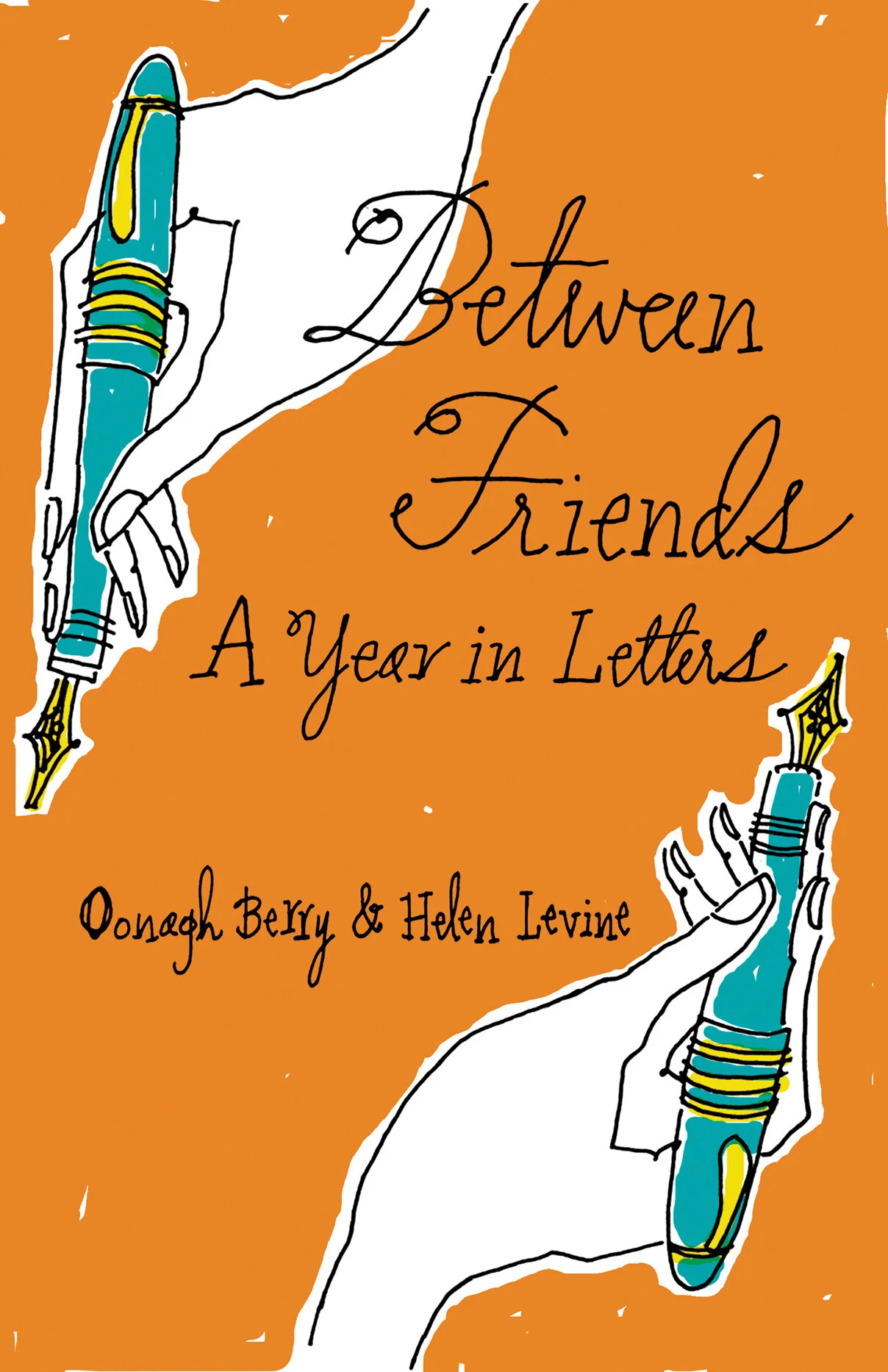REMEMBERING: Canadian History Recorded in Letters
/By Barry Penhale
At a neighbourly gathering at our farmhouse, a guest now into her 80s brought up the topic of pen pals — a term that today seems quaint and out-of-fashion. As it turned out our neighbour has kept up a cherished correspondence with two childhood friends for over seventy years. Just imagine the history these three faithful friends have witnessed and documented as they recorded, page by page, their daily experiences, in letters that have regularly made their way across the country.
Between Friends: A Year in Letters. Helen Levine & Oonagh Berry. Second Story Press, 2005.
Today, in a greatly changed era, memories alone remain to remind us of a once familiar sight of one’s mother seated usually at a kitchen table, her quiet place where she could be found lovingly writing newsy letters to family and friends — each letter written in perfectly formed handwriting. How times have changed! Now, instead of pen to paper, email messages are dashed off in record time or we text via a hand-held cell phone. Even this senior journalist now sits at his Mac — the days of tapping away on an old Underwood typewriter (remember those things) is now part of my own past.
Sad to say and personally speaking, what is left of my own handwriting (never as impeccable as my mother’s), is now regrettably reduced to a rather poor signature. A sad statement to be sure and unfortunately true!The acclaimed biographer and popular historian, Charlotte Gray, does, in my opinion, know more about the importance of letters written by known and little-known Canadians than any other author with whom I am personally acquainted. Her marvelous book, Canada: A Portrait in Letters, 1800–2000, (Doubleday Canada, 2003) occupies a place of honour on my home-office bookshelf alongside valued copies of other significant books by this talented non-fiction writer, winner of the 2003 Pierre Berton Award and undoubtedly one of Canada’s best biographers.
On the inside of the dust jacket, there appears the following quote from the author herself: “Letters have a magic all their own,” writes Charlotte Gray. “Like locks of hair, they encapsulate some essential element of the personality of whoever holds the pen. I can almost hear the writer speak to me, across time and distance.” Readers with Canadian history interests will find much to discover within her book. A selected few of the many hundreds of Canadians whose letters have been chosen include Robertson Davies, Glenn Gould, Grey Owl, Emily Carr, and Sir Wilfrid Laurier. Letters involving notable figures associated with Hastings County include Susanna Moodie, Flora MacDonald Denison, and Farley Mowat. Written from the heart, the countless letters found in this insightful volume represent a highly personal way ofexploring the history of our country.
My Dearest Wife. Maud J. McLean & Robert M. Stamp. Natural Heritage Books, 1998.
In 1998, the first edition of a delightful book titled My Dearest Wifeappeared in bookstores and libraries. Co-written by Maud J. McLean and the Canadian historian Robert M. Stamp, the book is a dual biography of James David Edgar and his wife, Matilda Ridout Edgar. Their loving relationship is captured through their devoted correspondence, written at the time of an emerging Canada. James David Edgar (1841-99), though the son of impoverished Scottish immigrants to Canada, was to become a well-known politician and ultimately speaker of the House of Commons in Ottawa following the victory of Laurier in 1896. He wrote a letter to his wife every day when required to be in Ottawa, hence the title of the book. Matilda Edgar (1845–1910), a most accomplished woman, become one of Canada’s most respected early female historians, president of the Women’s Historical Society of Toronto and until her passing, served as president of the National Council of Women of Canada. Together the couple made a substantial contribution to 19th-century Canada. The authors’ decision to use the “voices” of James and Tillie through their letters, writings, and speeches revealed much of both their private and public worlds. Interestingly, the printed acknowledgements within My Dearest Wife, includes a thank you to a younger-at-the-time, Heather Wakeling, now Country Roads’assistant editor.
Canada: A Portrait In Letters, 1800–2000. Charlotte Gray. Doubleday Canada, 2003.
Bancroft’s “Man of the Century” Henry Taylor, though living a whole lot longer than most letter writers, never made it into a Charlotte Gray book nor did he move in the elite circles known to James and Matilda Edgar. But as a natural storyteller, he brought to life some very rich rural Hastings County history through his letters and oral tapes. Fortunately, I have in my possession a packet of letters received from him long ago, each one of which I treasure. Henry’s letters could always be counted on to provide authentic snapshots of the past. It somehow seems fitting in examining our heritage through correspondence, to close with one or more delightful letters from one who in his own lengthy lifetime became living history.
February 5, 1981:
“My Mother, Mrs. Alex Taylor had a spinning wheel and she spun wool right off the back of our sheep and John Allison wove a pair of all-wool blankets, which she put on display at the Renfrew Fair and took first prize.” In his letters, Henry often mentioned his ancestors with pride, including his grandmother Mrs. Joe Stringer, whose maiden name was Isabella McAllister. “This same Grandmother of mine told me she only went to school one day of her life after a little log schoolhouse had been built in McNab Township. A British Army officer had been installed as a schoolmaster — he must have been one of those brutish Drill Sargeant (sic) types — for the very first day Grandmother was there he got a small boy who had no slate up on a bench to teach him how to make his letters and figures on the blackboard. The lad had done something to displease the schoolmaster for he just savagely caught the boy by the lobe of one of his ears and yanked him down the bench tearing the lobe of the lad’s ear right off the side of his head. When Isabella McAllister my Grandmother went home and told William McAllister that, he said ‘Well that’s no place for my daughter.’ So she never went back to school anymore. It wasn’t until us — her grandchildren brought our books home from school — we taught Grandmother how to read and write!”
An excerpt from another of Henry’s letters, also written in February 1981 reads: “This fall the Herman1School out on Hwy #500 East got my wife, Dorothy and I to lecture. Dorothy [was] to tell them what a country school was like 50 years ago, when she came into North Hastings to teach.” For his part, Henry, with some of his woodcarvings on display, shared memories of logging with horses half a century earlier. He also took delight in telling me that one of the teachers jokingly asked if he was there to enroll. When Henry enquired if any record might exist of his own limited schooling in the area, the teacher located an old register and there legibly recorded were the four days he had attended in the month of February 1912. Henry then went on to explain that as a seven-year-old his legs were too short to deal with massive snowdrifts, and further noted that back then a lot of school time was lost because of the severe winters. Henry’s particular brand of humour emerged when he ended as follows: “Well I guess I will close this Bancroft Times for now.”
Through his letters and folk art the well-liked Bancroft artisan, Henry Taylor, left behind delightful reminders of past years within the North Hastings/Madawaska Valley region he so proudly called home. Photo by Marc Solomon
Perhaps this is an appropriate time to suggest a new way of looking at handwritten letters — the time to think half full rather than half empty when opening that next envelope — should you be fortunate enough to receive such a rarity in today’s world.Surely there exists every possibility that future correspondence could easily contain some historical tidbits — the smallest of which could be meaningful to our understanding of family and its place in today’s Canada.
Ed. Note:
1. In the book titled Where the Heck is Balaheck? by Michael Dawber (General Store Publishing, 1995) the author shares his special interest in unusual Eastern Ontario place names. One particular entry reminds readers of two communities in Mayo Township, first known as Hermon & Upper Hermon and originally located where the old Snow Road crossed a short connecting route to the Peterson Colonization Road. Early growth encouraged the opening of a post office in 1878 and sometime afterward the now long-vanished hamlet came to be known solely as “Upper Hermon.” Later still this moniker was replaced by the male Christian name Herman. Whoever Herman was remains a mystery!






































